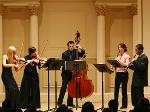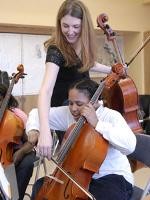Title
For the past six months, I have had the honor of being one of first 16 fellows in the pilot program of The Academy—A Program of Carnegie Hall, The Juilliard School, and The Weill Music Institute. As I write this, we are embarking on the second year of our fellowship while welcoming the 19 new fellows who joined the group in September.
Members of Ensemble ACJW in performance at Weill Recital Hall. Pictured are (left to right) violinis Joanna Kaczorowska, violist Nadia Sirota, bassist Kristoffer Saebo, clarinetist Carol McGonnell, and oboist Arthur Sato.
(Photo by Stefan Cohen)Academy fellow Claire Bryant works with a student at the Grove Hill School, P.S. 157X, in the Bronx.
(Photo by Jennifer Taylor)Body
The brainchild of Clive Gillinson, Carnegie Hall’s executive and artistic director, and Joseph W. Polisi, president of The Juilliard School, the philosophy of the Academy defines the performer and teacher as one entity, while emphasizing the importance of the 21st-century artist as an activist and citizen in society at large. This program challenges us with the following question: “Is it really enough to be a great performer?”
There are two major components to The Academy, the first being performance. In the upcoming 2007-08 season, the combined fellows will present more than 25 mixed chamber-music concerts on the stages of Carnegie Hall and Juilliard, as well two weeklong residencies at Skidmore College. In order to help prepare for these concerts, each individual ensemble may coach with any master musician in the New York area. In addition, fellows are offered 10 free lessons a year with teachers of their choice.
The second major component of the Academy is a two-year residency in a public school in the New York metropolitan area (all five boroughs will be represented this coming year). Fellows are each assigned a school where they teach for one-and-a-half days per week. Fellows attend intensive educational workshops provided by master teachers and clinicians in conjunction with the Department of Education to prepare for their residencies.
To help integrate the various aspects of the program, Academy fellows and administrators meet in a weekly forum to discuss pertinent issues of the arts in today’s society. The forums are led by guests from within and outside of the program, last year ranging from musicians such as Ethel, Wu Han, and David Finckel, to income tax and public relations experts. These meetings have helped to create an environment in which the fellows can speak freely about their experiences in the program, and as a result, have cultivated a sense of family within the group.
For me personally, the school residency has been especially life-changing. I was assigned P.S. 157x, an elementary school in the South Bronx. I had been to the South Bronx only one time in the past three-and-a-half years—for game two of the World Series in 2003. I had no idea what to expect as I ventured on the No. 2 train that February morning. When I got to the school after a short walk through the neighborhood, I met an adorable class of 12 violin students, arranged in a circle on a rug with musical motifs. As soon as I walked inside the doors of the vibrantly decorated room, the third-grade violinists greeted me with cheerful smiles and big hugs! Here I was, a stranger, but they met me with warmth and welcome.
I was very lucky to be working with an extraordinary teacher, Helen Carter Huybrechts, who created the strings program at P.S. 157x after retiring from a professional performance career. Observing her classes on my first day, I was blown away by the level of each group of 8 to 12 students she sees at a time. There are more than 250 students, in grades 2 through 5, who play the violin, viola, or cello. Amazingly, each child has the chance to play his or her instrument only 30 or 40 minutes per week because there just aren’t enough instruments in the school for students to take home and practice. But the level and amount of information and music they retain from week to week is unbelievable and is evidence, I believe, of Helen’s excellent teaching and dedication.
One of the most memorable moments for me was with a group of young cellists, when I first played my cello for them. I chose the first page of the Elgar Cello Concerto, and without preparing them with any information on the piece or composer, I launched in. They sat close to me on the floor so they could feel the vibrations of the “big” cello, as they called it. When I reached the top of the B-minor scale, there was a long moment of silence, which was broken by an explosion of tears and sobs from one of the girls.
Everyone, including Helen, was shocked by this reaction. I didn’t know what to do, or how I should handle it. I started by telling this student it was O.K. to cry, and asked her if she would mind talking about what she was feeling. She said, in between heaves, “I’m sorry ... it’s just, so sad. I don’t know how it [music] can make me feel this way, when there are no words.” The rest of the class played out like a therapy session.
That moment was the greatest testament to why I play music, as well as to the mission of the Academy. It was obvious how my presence as a teaching artist was contributing not only to the students’ musical experience, but to their entire lives, and to their budding characters.
It’s amazing how much I have changed personally through this experience. After only a few months, I need the kids as much as they need me. And my own personal and professional goals have stretched way beyond what they were a year ago. I can see now how passing on music to others can only strengthen and illuminate one’s own artistic growth. I think it is essential for all young artists today to get out of “the bubble”—the conservatory, concert hall, or practice room—and venture out into the “real” world. The Academy has challenged me and made it possible for me to do this.
The idea of the artist as citizen (to borrow the title of Joseph Polisi’s book on an artist’s role in society) is a vital philosophy and mentality we must embrace as the artists of the future. How can we expect our art to sustain itself if we stay within the bounds of our comfort zones? We must extend ourselves into our communities, and to the people in them. We are, after all, human; and what greater connection to the human condition, than through music?






